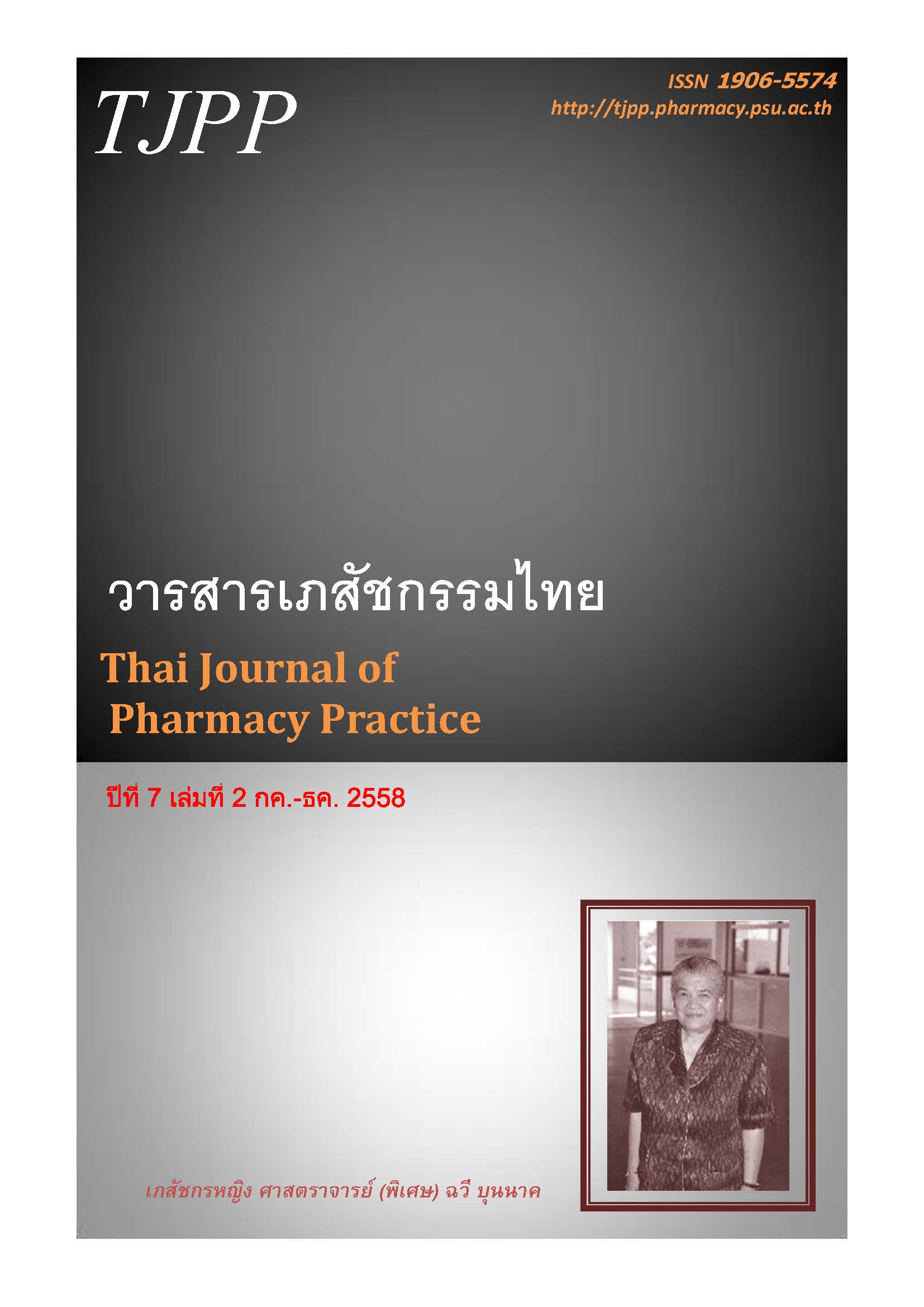การประเมินการใช้ยาสมุนไพรและยาแผนไทยของสถานพยาบาล สังกัดกระทรวงสาธารณสุขในจังหวัดร้อยเอ็ดในปี 2557
Main Article Content
บทคัดย่อ
วัตถุประสงค์ : เพื่อวิเคราะห์การใช้ยาสมุนไพรและยาแผนไทยของสถานพยาบาลสังกัดกระทรวงสาธารณสุขในจังหวัดร้อยเอ็ดในปี 2557 และศึกษาถึงปัจจัยที่ส่งเสริมและ อุปสรรคต่อการสั่งจ่ายยาดังกล่าว วิธีการศึกษา : ผู้วิจัยวิเคราะห์ข้อมูลจากฐานข้อมูล Data Center ในเรื่องของมูลค่าของการบริโภคยา การวินิจฉัยโรค และการสั่งจ่ายยา นอกจากนี้ ผู้วิจัยยังใช้แบบสอบถามเก็บข้อมูลเรื่องปัจจัยที่ส่งเสริมและอุปสรรคต่อการสั่งจ่ายยาสมุนไพรและยาแผนไทย ตัวอย่างที่ตอบแบบสอบถาม คือ ผู้เกี่ยวข้องกับการสั่งจ่ายยา 150 คน ประกอบด้วยแพทย์แผนปัจจุบัน จำนวน 3 คน ผู้ประกอบวิชาชีพเวชกรรมแผนไทย จำนวน 4 คน พยาบาล จำนวน 40 คน เจ้าพนักงานสาธารณสุขชุมชน จำนวน 86 คน นักวิชาการสาธารณสุข จำนวน 12 คน และเภสัชกร จำนวน 5 คน ผลการศึกษา : ในปี 2557 สถานพยาบาลสังกัดกระทรวงสาธารณสุขในจังหวัดร้อยเอ็ด มีผู้ใช้บริการที่แผนกผู้ป่วยนอกทั้งสิ้น 1,493,298 คน คิดเป็นการบริการจำนวน 5,851,144 ครั้ง ในจำนวนนี้เป็นผู้ป่วยที่รับบริการการแพทย์แผนไทย 223,058 คน หรือร้อยละ 14.94 รวมจำนวนครั้งของการบริการแพทย์แผนไทย 434,363 ครั้งหรือร้อยละ 7.42 สถานพยาบาลมียาสมุนไพรและยาแผนไทยเฉลี่ย 16.59+6.87 รายการ (พิสัย 5-34) มูลค่าการบริโภคยาสมุนไพรและยาแผนไทยรวมกันทั้งจังหวัด คิดเป็น 24,516,559 บาท หรือร้อยละ 3.13 ของมูลค่าการบริโภคยาทั้งหมด ผู้สั่งจ่ายยากล่าวว่า อุปสรรคต่อการสั่งจ่ายยาที่สำคัญมากที่สุด 3 ลำดับแรก คือ 1. ผู้สั่งจ่ายยาไม่รู้จักขนานยาและสรรพคุณยา 2. ผู้สั่งจ่ายยาไม่มีข้อมูลเพียงพอเกี่ยวกับยา และ 3. ผู้สั่งจ่ายยาไม่เชื่อมั่นในคุณภาพของยา สิ่งที่ส่งเสริมให้มีการสั่งจ่ายยาสมุนไพรและยาแผนไทย 3 ลำดับแรก คือ 1.การที่ผู้ป่วยเรียกหา 2.ผู้สั่งจ่ายยามีความเชื่อมั่นในยาสมุนไพรและยาแผนไทย 3.การมีกฎเกณฑ์ให้จ่ายยาสมุนไพรและยาแผนไทยเพื่อทดแทนยาแผนปัจจุบัน สรุป: การให้บริการผู้ป่วยด้วยการแพทย์แผนไทยยังมีอัตราที่ต่ำ จำนวนรายการยาสมุนไพรและยาแผนไทยของสถานพยาบาลและขนาดของสถานพยาบาลไม่มีผลต่อมูลค่าการบริโภคยาเหล่านี้ การส่งเสริมให้มีการใช้ยาสมุนไพรและยาแผนไทยต้องทำให้ผู้ป่วยและผู้สั่งจ่ายยายอมรับในประสิทธิภาพของยา ส่วนที่เป็นอุปสรรคสำคัญ คือผู้สั่งจ่ายยามีความรู้และทักษะไม่เพียงพอ ส่งผลให้อัตราการบริโภคยาสมุนไพรและยาแผนไทยยังคงอยู่ในระดับต่ำ
Article Details
ผลการวิจัยและความคิดเห็นที่ปรากฏในบทความถือเป็นความคิดเห็นและอยู่ในความรับผิดชอบของผู้นิพนธ์ มิใช่ความเห็นหรือความรับผิดชอบของกองบรรณาธิการ หรือคณะเภสัชศาสตร์ มหาวิทยาลัยสงขลานครินทร์ ทั้งนี้ไม่รวมความผิดพลาดอันเกิดจากการพิมพ์ บทความที่ได้รับการเผยแพร่โดยวารสารเภสัชกรรมไทยถือเป็นสิทธิ์ของวารสารฯ
เอกสารอ้างอิง
2. Department of Thai Traditional and Complimentary Medicine. Policy and direction of the Department of Thai Traditional and Complimentary Medicine B.E. 2558 – 2559 [online]. 2014 [cited 2015 Jan 30]. Available from: URL:http://www.dtam.moph. go.th/ images/Policy/policy_2558.pdf.
3. Nonting P, Charoenporn S, Kunwaradisai N, Watcharathanakij S, Vadhnapijyakul A. Situation and restrictions for the use of herbal medicines in public hospitals. Isan Journal of Pharmaceutical Sciences. 2013 ; 9 : 29.
4. Working group in Thai Traditional Medicines at 7th region. Summary of the result of an effort to strengthen Thai traditional medicines: report of the 2nd meeting in 2014. Roi-Et: Roi-Et Public Health Office; 2014.
5. Roi-Et Public Health Office. Report on central standard from 43 files. [online]. 2013 [cited 2014 Nov 20]. Available from: URL:http://www.sasuk 101.net.
6. Cochran WG. Sampling techniques. New York: John Wiley and Sons:, 1977.
7. Bureau of Drug Control, Food and Drug Administration. List of herbal medicines. [online]. 2013 [cited 2014 Nov 1]. Available from: URL: http://drug.fda.moph.go.th:81/nlem.in.th/medicine/ herbal/list
8. Sakonnakorn Public Health Office. Handbook on list of 45 herbal medicines in governmental public health facilities in Sakonnakorn (according to the 4th National Essential Drug Lists, B.E.2555). Sakonnakorn: Sakonnakorn-karnpim Printing; 2012.
9. Committee on the Development of Guidelines for Thai Traditional Practice in Public Health care Facilities. Guidelines for Thai Traditional Practice in Public Health care Facilities. Bangkok: Publishing House of the War Veterans Organization; 2007.
10. Jehso K, Lerkiatbundit S, Wiroonpanich W. Integration of Thai traditional medicine into physicians' practice part 1: Conditions facilitating the integration. Thai Journal of Pharmaceutical Sciences 2015; 39: 49-56.
11. Jehso K, Lerkiatbundit S, Wiroonpanich W. Integration of Thai traditional medicine into physicians' practice part 2: Raising consciousness, the process of integration from physicians' experiences. Thai Journal of Pharmaceutical Sciences 2015; 39: 57-63.


